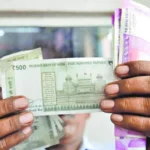The historic ceremonial sceptre known as “Sengol,” which was presented to India’s first prime minister, Jawaharlal Nehru, as a symbol of power transfer in August 1947, is set to find a new home in the recently constructed Parliament building in Delhi. Official sources have confirmed that the sceptre, made of silver with a gold coating, will be installed near the chair of the Lok Sabha Speaker on May 28. This significant event coincides with the dedication of the new Parliament building to the nation by Prime Minister Narendra Modi.
Union Home Minister Amit Shah, while addressing a press conference, highlighted the symbolic importance of Sengol. He emphasized that the sceptre represents the historic transfer of power from British rule to India, mirroring its original purpose during the Chola dynasty in Tamil Nadu, where it was utilized to mark the transition of power between kings.
The decision to relocate the Sengol sceptre from its previous home in the Nehru Gallery of the Allahabad Museum to the new Parliament building has been met with both anticipation and reverence. The move is seen as a gesture to honor the historical significance of the sceptre and to ensure its preservation for future generations.
Sengol holds immense historical value as a tangible artifact associated with the independence and nation-building process of India. It was bestowed upon Jawaharlal Nehru during a momentous period when India was on the cusp of its newfound freedom. The sceptre symbolizes the hopes, aspirations, and struggles of the Indian people as they embarked on a journey towards self-governance.
The decision to install the sceptre near the Lok Sabha Speaker’s chair is significant, as it reinforces the principles of democracy, parliamentary authority, and the power vested in the people of India. By placing Sengol in such a prominent position, it serves as a constant reminder of the struggles and sacrifices made by those who fought for India’s independence.
The transfer of the sceptre to the new Parliament building is a meticulous process, ensuring its utmost safety and preservation. Experts in art conservation and heritage management are involved in every step to maintain the sceptre’s original condition and prevent any damage during the installation.
The new Parliament building itself is an architectural marvel, designed to accommodate the evolving needs of India’s democratic system. It is a testament to the country’s progress and ambition, reflecting India’s stature on the global stage. The inclusion of Sengol in this new structure further enhances its significance, underscoring the deep-rooted connection between India’s past and present.
As the new Parliament building is dedicated to the nation, Prime Minister Narendra Modi will commemorate this historic event. The presence of Sengol during the dedication ceremony will serve as a poignant reminder of India’s journey towards self-rule and the responsibilities that come with it.
The installation of Sengol in the new Parliament building will undoubtedly attract attention from historians, scholars, and the general public alike. Its presence will provide an opportunity for visitors to learn about India’s rich history and the struggles faced by its leaders in shaping the nation.
The installation of the Sengol sceptre in the new Parliament building is a significant moment in India’s history. This cherished artifact, steeped in symbolism and historical value, will now reside in a place of prominence, reinforcing the democratic ideals and the enduring legacy of India’s independence movement. Its relocation to Delhi signifies the importance of preserving and honoring India’s past as it forges ahead into the future.









